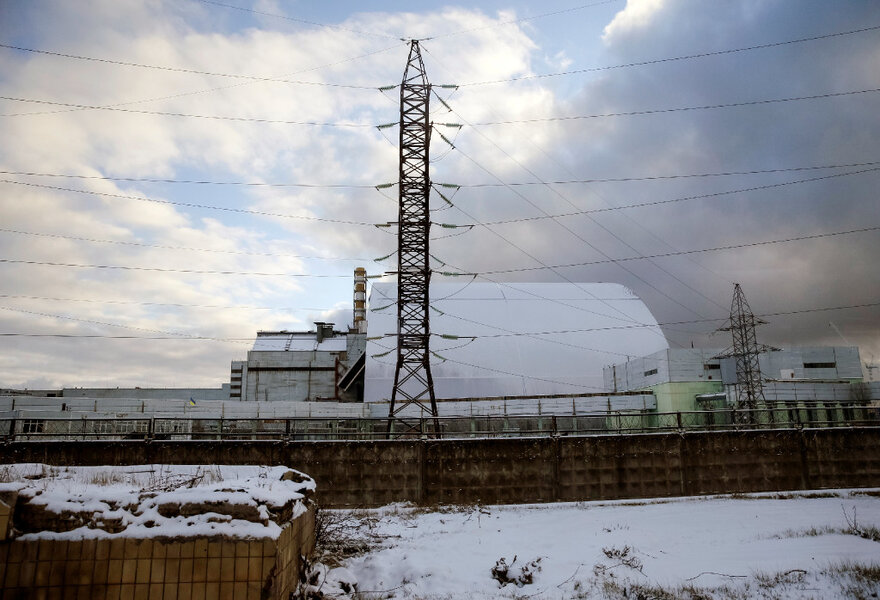World's largest land-based moving structure to enclose Chernobyl
Loading...
More than three decades after the worst nuclear disaster in history, Ukraine has slid a massive containment shield over the failed Chernobyl nuclear reactor.
Designed and constructed by the French firm Novarka, the hangar-like New Safe Confinement (NSC) structure aims to keep radiation from escaping the site for the next 100 years while nuclear engineers work to stabilize the area.
The disaster occurred in northern Ukraine in 1986, when a flawed reactor operated by inadequately trained personnel caused a steam explosion and fires that released more than five percent of the radioactive reactor core into the atmosphere. Some 50,000 people were forced to evacuate their homes, and an area the size of Luxembourg surrounding the site is still considered uninhabitable.
“This is a major step forward,” Timothy Mousseau, professor of biological sciences at the University of South Carolina in Columbia, tells The Christian Science Monitor in a phone interview. “It represents a lot of effort by a lot of people from around the world to take this first step toward cleaning up this disaster site.
"But in terms of the broader consequences of the Chernobyl disaster," Professor Mousseau adds, "there is still a lot that remains to be done – including basic research on the health and environmental consequences of the lingering radioactivity that still affects large parts parts of Eastern and Central Europe.”
An estimated 30 cleanup workers died within weeks of the accident, and the United Nations estimates that another 4,000 civilians were killed or died from the accident in the years that followed.
Many have since blamed Soviet isolationism and the resulting lack of safety standards for the disaster. However, this most recent step toward minimizing the effects was a global effort. Funds for the $2.2-billion project, organized by The European Bank for Reconstruction and Development, came from countries from all over the world.
The site remains highly radioactive, and therefore it was considered too dangerous to build the containment system on site. Instead, engineers built the half-cylinder shaped NSC off-site and then transported it to the reactor on a system of hydraulic jacks.
“This was a very creative approach of what to do when you cannot build a structure directly on top of the old disaster site, in this case because of high levels of radioactivity and the relative instability of the old reactor site,” Mousseau says. “This required building the new structure remotely and then slowly sliding it into position to protect the workers from the radiation that continues to be given off by the reactor.”
The new shelter, which is the largest land-based moving structure in the world, and took two weeks to move from its original location, slid into place over the reactor on Tuesday. The massive structure is roughly 350-feet high and 530-feet long and is designed to withstand extreme temperatures, corrosion, and tornadoes.
"Let the whole world see today what Ukraine and the world can do when they unite, how we are able to protect the world from nuclear contamination and nuclear threats," Ukrainian President Petro Poroshenko told Reuters.
This is not, however, the first attempt at building a shelter over the exploded reactor.
In the wake of the disaster, a preliminary sarcophagus was hastily built over the remains of the nuclear reactor site in order to contain the spread of radiation into surrounding areas. The Soviet-era structure supposedly had a lifespan of 30 years, but it began to deteriorate much sooner, causing worry that it could collapse and spew radioactive dust into the air, resulting in another disaster with consequences as far-reaching as the first.
But there was little Ukraine could do at the time.
“Ukraine is a very poor country and following the collapse of the Soviet Union in 1991, Ukraine was left holding the bag on this Chernobyl disaster and they just haven’t had the resources to deal with the clean up on their own ... and Russia was not there to support the clean up in any substantive way,” says Mousseau.
It took several decades to raise the money and to develop the technology to safely build the NSC. The new structure will surround the Soviet-era enclosure and allow workers to safely begin deconstructing the old structure, decommissioning the reactors, and removing the spent fuel.
No two nuclear disasters are same, so it is unclear whether this strategy can be applied elsewhere, but Mousseau says that Fukushima and Chernobyl may be similar enough to apply lessons learned in the clean up of one to the other.
“There will certainly be a fair bit of technology transfer from Chernobyl to Fukushima. That has already occurred. But since every accident is different it is not clear how likely this particular exercise is to facilitate responses in the future.”
Material from Reuters contributed to this report.








